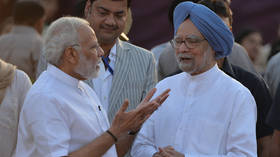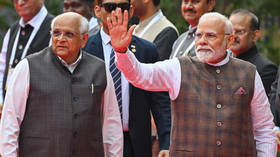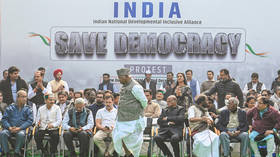Top-down or bottom-up? As elections approach, Modi-led party is set to test two economic philosophies

Last week, India’s ruling Bharatiya Janata Party (BJP)-led National Democratic Alliance (NDA) tabled a white paper in Parliament chronicling the last two tumultuous decades of the national economy.
It was the NDA’s version of a comparison of its decade in office versus the tenure of its predecessor and arch political rival, the Congress-led United Progressive Alliance (UPA), between 2004 and 2014. To be sure, the Congress sought to rain on NDA’s parade by coming out with a “black paper” of its own.
Effectively these two papers document the clash of two economic ideologies piloted by the two prime ministers, the incumbent Narendra Modi and former leader Manmohan Singh – asking the nation to choose between Modinomics and Manmohanomics.
The timing of the paper, just weeks before the Election Commission of India kicks off the general election cycle, suggests that the NDA is looking to score political brownie points against its rival.
While this is indeed the case, it is also the first time in recent economic history that an incumbent government is making its electoral case based on its record in office pioneering unprecedented and often disruptive economic reforms.
More importantly, it held out the promise of more reforms to come in its third term – which the NDA believes is its for the taking.
Significantly, all this ‘chutzpah’ comes from a government facing the difficult odds of a two-term anti-incumbency. This bold political gambit is why NDA’s white paper on the Indian economy is so significant. It seeks to mainstream the idea of economic reforms by linking it to the current government’s reelection.
Splitting hairs
On the face of it, the two regimes, NDA and UPA, are at either end of the ideological spectrum. Broadly, the UPA led by PM Singh made pro-poor its cause and batted for the entitlement of those at the bottom of the pyramid. This is best summed up by the UPA’s signature social safety net program, the Mahatma Gandhi National Rural Employment Guarantee Scheme (MGNREGS), with an annual average spend of 750 billion rupees ($9 billion) – something the NDA retained despite expressing reservations.
In contrast, the NDA led by PM Modi opted for the strategy of pro-poor and pro-business, preferring empowerment over entitlement. This meant universalizing access to basics – electricity, cooking gas, banking, housing, drinking water, health insurance, and so on – and thereby empowering people and creating a stronger economic fabric to sustain business opportunities. A strategy of teaching people how to fish, rather than giving them fish.
The NDA is, through the white paper, showcasing to potential voters its ability to have successfully pulled this off in its last ten years in office. Despite being bitter political rivals, the NDA and UPA have far more in common, especially with respect to economics, than they would care to admit.
Both regimes are committed to the idea of economic reforms. This bipartisan consensus has enabled the two regimes to pivot India towards a market-based economy. But they differ on the scale and calibrating the pace of such change.
While the UPA preferred an incremental approach, the NDA opted for an aggressive, risky, and calibrated approach to economic reforms. It however sequenced the roll-out of basics first and staggered disruptive initiatives like the Goods and Services Tax (GST), which has integrated multiple indirect taxes on goods and services varying from state to state into one unified tax, and the privatization of government-owned companies – which included the sale of the national air carrier Air India to the private sector conglomerate Tata Sons.
Ironically, the NDA was able to accelerate the roll-out of basics by leveraging its inheritance from the UPA. ‘Aadhaar’, the 12-digit identity for all residents, was rolled out by the Singh-led government in 2009. Though the UPA erred in failing to provide legal cover for the idea, this did not deter it from experimenting with it to test direct benefits transfer (government payments to the citizens living below poverty line) through pilot projects. The lack of a political will meant that these ideas largely remained experiments.
The Modi-led NDA, on the other hand, was endowed with abundant social capital – earned by the BJP when it became the first party to win a majority on its own since 1984. It seized on the opportunity it inherited, and successfully implemented direct benefits transfer by pairing an individual’s bank accounts (‘Jandhan’) created under a government scheme to provide easy access to financial services and ‘Aadhaar’ with their mobile, arriving to a ‘JAM’ formula (Jandhan-Aadhaar-Mobile) – akin to an ‘economic GPS’ to identify a beneficiary.
As a result, not only was the NDA able to target welfare programs, but it also managed to reduce leakages and theft – resulting in cumulative savings of a staggering 2,750 billion rupees ($33 billion) to the national exchequer. This double whammy earned it more social capital, making it easier for Modi to convincingly link the benefits of development with continued reform of the economy.
More in the offing
Beginning with the president of India’s address to both Houses at the start of the just-concluded budget session of Parliament on January 31, the Modi-led government has continued to signal its commitment to reforms. This was then echoed in the interim budget presented by Finance Minister Nirmala Sitharaman on February 1 and Modi’s reply during the motion of thanks for the president’s address. The PM argued that the UPA government, unlike the NDA, had failed because it had been timid and pursued economic reforms only “incrementally.”
In fact, the white paper presented to Parliament, while being an elaborate listicle of the NDA’s development successes, also makes clear that it wants to stir an “informed debate on the paramountcy of national interest and fiscal responsibility in matters of governance and political expediency”. To be fair, this regime has already stirred the pot of competitive electoral freebies which pose a severe drag on the exchequer.
Significantly, a few days earlier, Sitharaman’s interim budget strikingly stuck to the committed path of fiscal consolidation and eschewed any electoral freebies – the first time a pre-poll budget has done so.
To be sure, in 2019 the NDA announced a stipend to small farmers which costs the exchequer 600 billion rupees ($7.23 billion) annually – matching the 600 billion rupees farm loan waiver announced by the UPA in the run-up to its reelection in 2009. Implicitly, the NDA is signaling its willingness to walk its talk to shun populism.
Finally, the white paper makes clear that the third term of the NDA, assuming it is reelected, will press the accelerator on economic reforms.
Indeed, this is the first time that any regime in modern India has come out so openly in support of economic reforms and spoken out against populism at the same time. To a large degree, the majority mandate – the first in three decades – won by the BJP in two successive general elections has enabled it to manage this pivot. And now, in its own words, it wants to raise the bar. We will have to wait till May to see how this political gambit plays out on the ground with India’s 700 million-plus voters.
Where India Meets Russia – We are now on WhatsApp! Follow and share RT India in English and in Hindi
The statements, views and opinions expressed in this column are solely those of the author and do not necessarily represent those of RT.
















